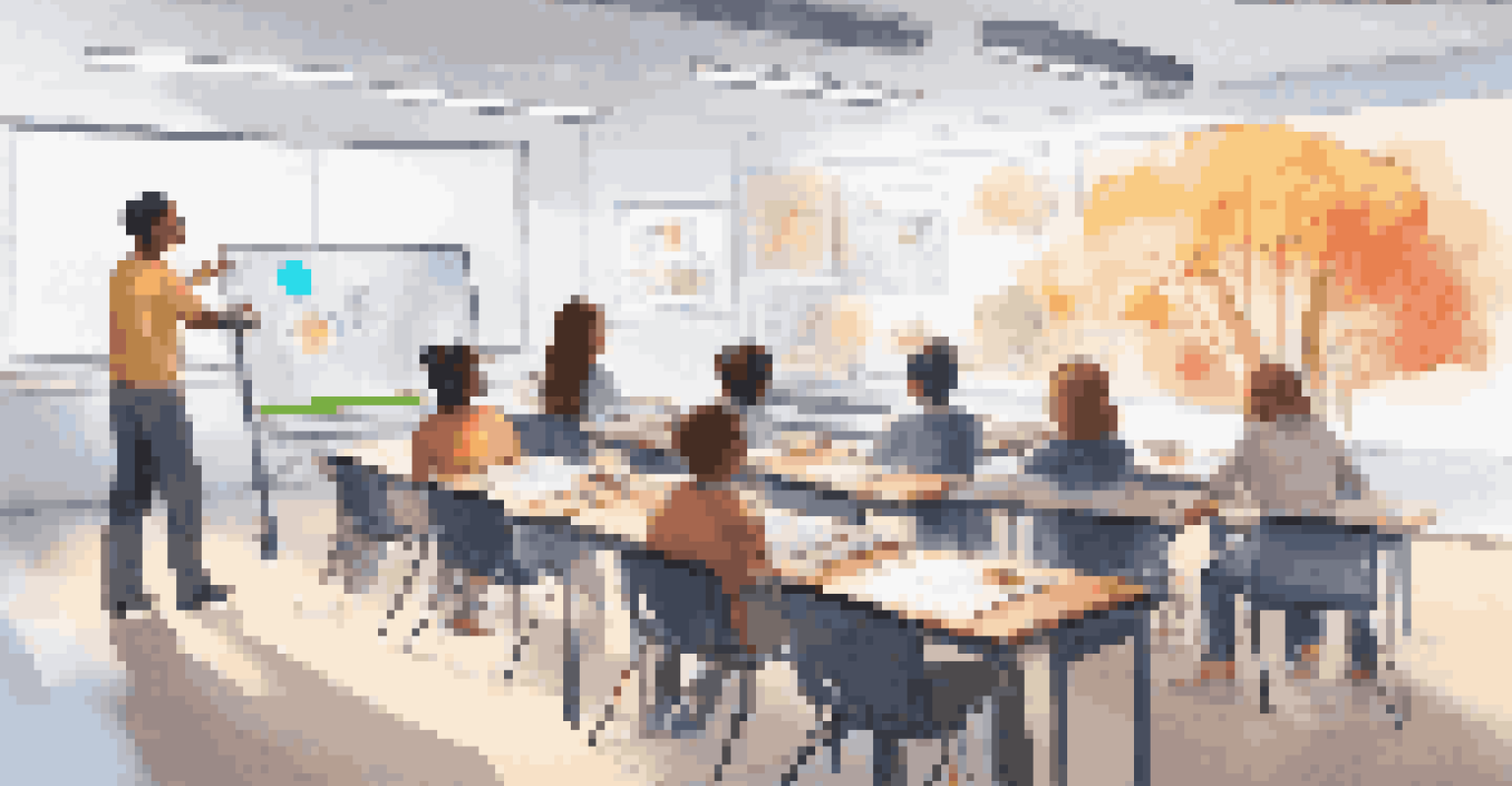Enhancing Collaborative Learning with AI-Powered Tools in Class

Understanding Collaborative Learning in Modern Classrooms
Collaborative learning is a teaching method that emphasizes teamwork and collective problem-solving. It allows students to engage with one another, share diverse perspectives, and develop critical thinking skills. By working together, students often retain information better and gain valuable social skills, preparing them for real-world interactions.
Collaboration allows us to know more than we are capable of knowing by ourselves.
In today’s digital age, the integration of technology in the classroom has reshaped how collaborative learning takes place. This shift not only enhances communication but also opens up new avenues for interaction among students. With the right tools, educators can foster an environment where collaboration thrives, making learning more dynamic and interactive.
However, traditional methods of collaboration can sometimes fall short in engaging every student, especially in larger classrooms. This is where AI-powered tools come into play, providing innovative solutions to facilitate and enhance collaboration. These tools can cater to diverse learning styles, ensuring that every student has a voice in the learning process.
The Role of AI in Enhancing Collaborative Learning
Artificial Intelligence (AI) refers to computer systems designed to perform tasks that typically require human intelligence, such as understanding language and recognizing patterns. In the context of education, AI can analyze student interactions and provide insights that help tailor collaborative experiences. This means that educators can receive feedback on how well students are working together and where improvements can be made.

AI tools can facilitate group assignments by matching students based on their strengths, interests, and weaknesses. For example, an AI platform might analyze a student's performance data and suggest ideal group members to complement their skills. This personalized approach not only boosts confidence but also encourages a more productive and balanced collaborative environment.
AI Enhances Collaborative Learning
AI tools improve student interaction and engagement by personalizing group dynamics and monitoring participation.
Furthermore, AI can assist in monitoring group dynamics in real-time. By identifying which students are participating actively or which may be struggling to engage, educators can step in promptly to provide support. This proactive approach ensures that no student is left behind, fostering a more inclusive learning atmosphere.
Examples of AI Tools for Collaborative Learning
There are several AI-powered tools available that can significantly enhance collaborative learning. For instance, platforms like Google Classroom and Microsoft Teams have integrated AI features that simplify group project management. These tools allow students to communicate seamlessly, share resources, and track progress, all while benefiting from AI-driven suggestions for improvements.
Technology will not replace great teachers, but technology in the hands of great teachers can be transformational.
Another notable example is the use of intelligent tutoring systems. These systems can analyze student interactions and provide personalized feedback or additional resources tailored to their needs. Tools like Carnegie Learning or Knewton not only support collaborative efforts but also enhance individual learning experiences.
Moreover, AI-based language translation tools can break down language barriers among students from diverse backgrounds. Platforms like Duolingo or Google Translate can facilitate communication in group projects, making collaboration more accessible for everyone. This inclusivity encourages participation and enriches the learning experience.
Creating a Collaborative Environment with AI
To successfully implement AI tools in collaborative learning, educators must first create a supportive environment. This involves establishing clear objectives for group work and encouraging open communication among students. When students feel comfortable expressing their ideas and challenges, they are more likely to engage fully in the collaborative process.
Educators can also set up training sessions to familiarize students with AI tools and their functionalities. Providing students with the necessary skills to navigate these platforms ensures that they can make the most of the technology available to them. This training can also foster a sense of ownership, empowering students to take charge of their collaborative learning experiences.
Creating Supportive Learning Environments
Establishing clear objectives and open communication is vital for effective collaboration using AI tools.
Additionally, it’s essential to continuously assess the effectiveness of AI tools in promoting collaboration. Gathering feedback from students can provide valuable insights into what works and what might need adjustment. This iterative approach allows educators to refine their strategies and ensure that collaborative learning remains effective and engaging.
Challenges in Implementing AI-Powered Collaborative Tools
While AI tools offer numerous benefits for collaborative learning, there are challenges that educators may encounter. One significant concern is the potential for over-reliance on technology, which could undermine the development of essential interpersonal skills. It’s crucial to strike a balance between using AI tools and fostering face-to-face interactions among students.
Another challenge is ensuring equitable access to technology. Not all students may have the same level of access to devices or reliable internet connections, which can hinder their ability to participate fully in collaborative activities. Educators must be mindful of these disparities and seek solutions to ensure that all students can engage meaningfully.
Finally, there’s the matter of training educators themselves. Teachers need to be adequately trained not only to use AI tools but also to integrate them effectively into their teaching practices. Professional development opportunities can help educators understand the best ways to leverage technology while maintaining a focus on collaboration and meaningful learning.
Future Trends in AI and Collaborative Learning
As technology continues to evolve, so too will the opportunities for enhancing collaborative learning through AI. Emerging trends suggest that AI will become more intuitive, making it easier for educators and students to engage with these tools. Future advancements may include more sophisticated analytics that provide deeper insights into group dynamics and individual participation.
Moreover, we can anticipate the rise of virtual and augmented reality experiences that incorporate AI, enriching collaborative learning in immersive ways. Imagine students from different parts of the world collaborating on a project while experiencing a virtual environment together—this could revolutionize how we think about teamwork and learning.
Challenges of AI in Education
Educators face hurdles like technology over-reliance and unequal access, which can affect collaborative learning outcomes.
Ultimately, the future of collaborative learning with AI is bright, promising a more connected and personalized educational experience. As educators and students continue to embrace these technologies, the potential for deeper engagement and understanding will only grow, paving the way for innovative learning experiences.
Conclusion: Embracing AI for Collaborative Learning Success
Enhancing collaborative learning with AI-powered tools is not just about integrating technology; it's about reimagining the way students engage with each other and their learning. By leveraging AI, educators can create more inclusive, dynamic, and personalized learning environments that cater to the diverse needs of students. This approach promotes not only academic success but also essential life skills, such as teamwork and communication.
As we move forward, it’s essential for educators to embrace these tools and continuously seek ways to improve their implementation. By staying informed about the latest advancements in AI and collaborative learning strategies, educators can ensure that they are providing the best possible experiences for their students. This commitment to innovation will ultimately foster a generation of learners who are well-prepared for the challenges of the future.

In conclusion, the integration of AI in collaborative learning is a powerful step towards creating more engaging and effective educational experiences. As we explore these tools and their potential, it's clear that the future holds exciting possibilities for both educators and students alike.